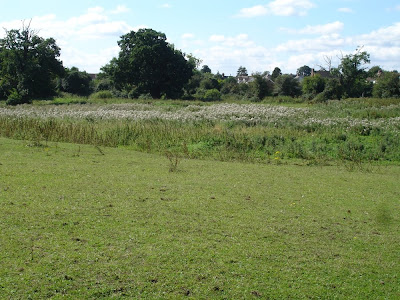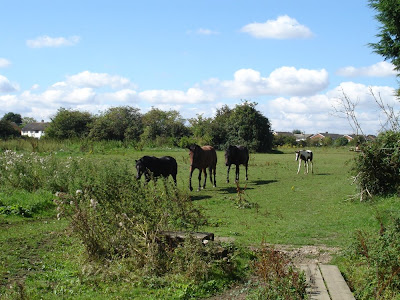Visiting the church at Broomfield with its prehistoric stones, one set in the wall of the church by the porch, the other two stones outside the wych gate, I became fascinated by the story of the Dragon pond and associated streams that were to be found in this area. Such stories are of course made up of myths but dragons and Saxons are an alliance that warrants a little more study, and a rich princely Saxon burial found here at Broomfield needs at least some notes.
The burial was excavated by Sir Hercules Read in 1894 and some of the finds found there way into the British Museum, one particular interesting find was a pyramidal jewel, and here I will quote from a BM Guide to Anglo-Saxon Antiquities 1923..
Plaited gold wire is also seen on the pyramidal jewel from the richly furnished burial at Broomfield, Essex..... The purpose of such pyramids is at present unknown, but its garnet inlay and the small piece of cell-work associated with it point to a Kewntish origin, which is of interest in view of the paucity of relics from the East Saxon territory. The interment was found 6 or 7 feet below the surface in a line ESE andWNW, and it appeared as if a warrior had been placed in a wooden coffin and burnt on the spot, but the total disappearance of the skeleton has been often noticed in Kent. His sword was recovered, and near the centre of the grave was a bronze pan, 13 inches in diameter, with a pair of drop handles, resting on fabric of two qualities. The vessel contained a cow's horn, two squat vases of blue glass and two wooden cups, turned on the lathe and furnished with rims of gilt bronze. As the pottery of the period outside Kent was hand-made, the use of the lathe may imply contact with the Jutish kingdom, which was then at its zenith.
The grave also contained two wooden buckets with iron mounts, 12 inches in diameter and 10 inches deep, which had been sunk into the floor, and a hemispherical iron cup on a tall stem terminating in four feet. This had a height of over 11 inches and may correspond to the bronzevessel of the Taplow burial. There were in addition a deep cylindrical cauldron of iron holding about 2 gallons, a shield boss with indications of a wooden shield, and a grey wheel-turned vase with impressed chevrons, singularly like one from the King's Field, Faversham...
Saxon burial, found in 1888, in gravel pit behind Clobb's Row.
Workmen digging gravel found remains of a sword, spear and knife 6-7 feet down. The sword's wooden sheath seemed to have been bound with tape-like material. With the sword were a gold pyramid and buckle plate, both set with garnets. the site was excavated in 1894. The northern part of the grave had been cut away.. The grave was curiously formed , dome-shaped and with curious extensions at the corners, and was c.8 feet long. The grave walls were covered with soot or charcoal. At the end of the grave were rows of large flint nodules. Flints and Roman tile fragments were found throughout the fill. A two-handled circular bronze pan was found on the eastern side of the centre of the grave.. It lay on a mass of folded woollen fabric of two qualities and some coarse material, apparently flax (including perhaps reddish tufts from a hairy cloak, of which there are quantities in the BM) and supported by logs of birchwood lying E-W, close together. In the pan were the tips of two cow's horns, two blue glass bowls, two lathe-turned wooden cups with gilt bronze rims. Nearby were two wooden buckets with iron mountings, sunk into the earth. A hemispherical iron cup on a tall stem, with four feet, was found in the middle of the south side of the grave; it was full of a hard, compacted mass of sand. In the south-west corner of the grave was an iron cauldron. At the north end was a sword, spearhead, shield boss and sherds of a wheel- thrown pot, ornamented with an impressed lozenge stamp. Between the pan and the west end of the grave a good deal of very dark matter was found, presumably charcoal, fragments of wood, parts of flat iron bars, angle irons and rivets. No sign of a body, the excavators thought it had been placed in a coffin and then burnt. The finds had no signs of fire damage. Possibly it was a southerly example of a half-burnt burial.
The burial has many similarities to the Taplow, Bucks., burial in its richness and the arrangement of the objects. Both are considered to be 'princely burials'. Finds in the British Museum.
The area in front of the church

This hollowed out dip is large and maybe the quarried gravel pit, the centre is filled with hemp agrimony and horses graze over this large area surrounded by houses.
 A small footbridge over a stream? towards the hollow leading from the pond (or? the excavated saxon burial)
A small footbridge over a stream? towards the hollow leading from the pond (or? the excavated saxon burial)
To the right deep pond like depression ringed with a small bank
History of church
British History online.....
WOOD BUCKET (Dated 600AD To 700AD)








British History online.....
These vases resemble very closely those found in a rich grave in a barrow atBroomfield, Essex. (fn. 13) Next comes a bronze situla or bucket, 9 in. high, both in form and fabric totally unlike Saxonwork (Pl. XXVIII g). (fn. 14) It was evidently a treasured object, since it has been neatly patched across a crack just below the rim. It remained for Sir Martin (later Lord) Conway to appreciate the true nature and source of the vessel. (fn. 15) He demonstrated beyond question the Coptic workmanship of the piece, showing that the flange at the base was intended to fit into a stand (now, or even at the time of its deposition, wanting), and that it could thus be brought into line with other imported bronze vessels of Coptic origin, like those from Taplow barrow and graves in various Kentish cemeteries. The normal attribution of exotic objects like the above to the 7th century is corroborated by the last piece figured in the original account. This is a fragmentary object of gilt bronze, decorated with studs set with garnet carbuncles, and with plait-ornament, a decorative combination that can claim a similar dating in Anglo-Saxon style. At Broomfield, too, a pyramidal jewelled stud has an edging of pseudo-plait gold filigree that marks work of the same period.
WOOD BUCKET (Dated 600AD To 700AD)
IRON CAULDRON (Dated 600AD To 700AD)
WOOD COFFIN (Dated 600AD To 700AD)
WOOD DRINKING VESSEL (Dated 600AD To 700AD)
IRON LAMP (Dated 600AD To 700AD)
IRON SHIELD (Dated 600AD To 700AD)
IRON SPEAR (Dated 600AD To 700AD)
IRON SWORD (Dated 600AD To 700AD)
POTTERY VESSEL (Dated 600AD To 700AD)
The Arts in Early England 1915
http://www.britishmuseum.org/explore/highlights/highlight_objects/pe_mla/b/blue_glass_jar.aspx
http://www.britishmuseum.org/explore/highlights/highlight_objects/pe_mla/b/blue_glass_jar.aspx
No comments:
Post a Comment
Love having comments!